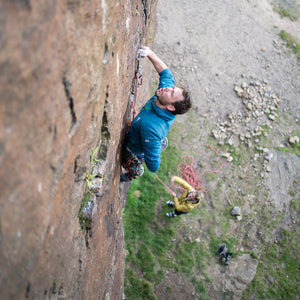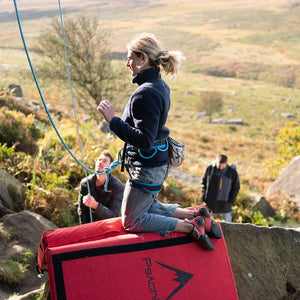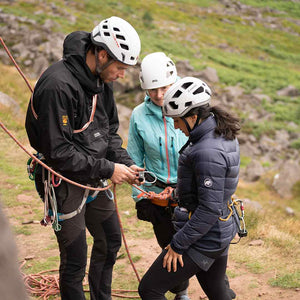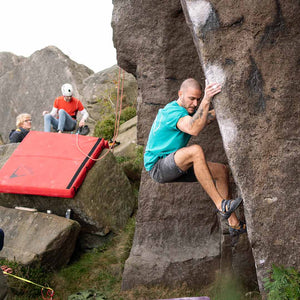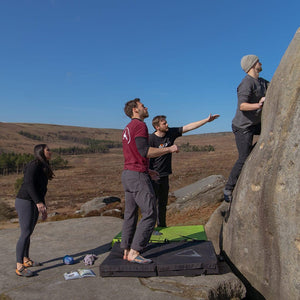What Is Trad Climbing?
As the name might suggest, traditional climbing or ‘trad climbing’ is often referred to as the original form of climbing, but what exactly is it, and how does it differ from the disciplines of climbing we may be more familiar with?
Trad climbing is a form of climbing where a climber ascends a rock face, placing their own protective gear as they climb. Should they fall, the gear they’ve placed on their way will hopefully protect them. Due to the added element of placing gear, traditional climbing carries a higher level of risk than pre-bolted sport climbing or bouldering. It is arguably a more mentally challenging discipline of climbing as the room for error is significantly reduced and incorrect gear placement or failure could prove deadly. As with all other forms of climbing, the standard equipment for trad climbing includes a climbing rope, climbing chalk, a belay device and climbing shoes. We also recommend taking a bag or sturdy duffle to help you keep your equipment organised.

How do you place trad climbing gear?
Whereas in sport climbing, pre-placed bolts provide a safe place to clip in as you climb and bouldering requires no rope at all, traditional climbing requires the lead climber to place their gear along the route as the climb. The type of gear a climber will choose to use depends on the nature of the rock features present on their route and how big these features are. The lead climber might place pieces of equipment such as a cam, hex or nut in fissures and breaks in the rock which they would then attach themselves to using a quickdraw. When a climber has reached the top of a climb an anchor must be set up to allow the leader to bring up the seconder safely. An anchor has a number of different components that can be arranged to ensure safety.
Because placing gear and building anchors is critically important, it can take a long time and lots of practice to get right. Because of this, building confidence with trad climbing is often a steep learning curve, largely because of the risks attached.
The different types of trad climbing gear
As traditional climbing has progressed as a discipline over the years, developments in equipment and gear manufacturing have made it much safer and easier to undertake. The evolution of trad climbing has seen the development of specialised equipment such as nuts, cams, slings and other pieces of kit. So what exactly does each piece of gear do?
Nuts
Climbing nuts are the integral base of a comprehensive trad rack. Simply, they’re a piece of metal that can be inserted into a rock face and placed so that when pulled, they stay put.
Wedges
Wedges are tapered chunks of metal, usually attached to a wire, that are wedged or jammed into or behind cracks or holes in the rock.
Cams
Cams are more sophisticated devices that constrict and release themselves to fit into a crack and cam the distance. Cams are more rounded and are twisted or rocked in order to jam into place.
Hexes
Hexes are larger, hollow nuts that are used when the placement is slightly wider than a nut would be applicable for.
Slings
Slings are a loop of webbing that work in conjunction with other protective equipment. They can be used to wrap around sections of rock and used as runners or anchors.
Removing gear
At the heart of traditional climbing is the ethics associated with leaving a rock face exactly as you found it. That means all the gear you place has to be removed once you’ve finished climbing.
To do this, a climber will lower off the route using a fixed anchor at the top or by wrapping rope around a tree or rock. In some cases rock climbers get their gear back as they belay their partner up after them
A nut tool may also come in handy for releasing cams and nuts that get stuck in the rock.

Where to go trad climbing
Unlike sport climbing, speed climbing and bouldering, which have all enjoyed a recent spike in popularity due to the rise of indoor climbing walls, trad climbing can only be undertaken outdoors on real rock. That means there’s a practically endless list of possible trad climbing locations - wherever there is rock with features to place gear in, you’ll be able to climb it using a combination of equipment if it is legal to do so.
Multi-pitch or single pitch trad climbing?
Trad climbing can be completed in single pitches, meaning just one route is climbed, or as a multi-pitch, meaning each climb has multiple sections or pitches. A single pitch climb is a route that only requires one length of rope to complete whereas multi-pitch climbing more often requires more than one rope. In both multi-pitch climbing and single pitch climbing, once a pitch is completed by the lead climber, they are then responsible for securing themselves with a safe and stable anchor from which to to belay the second climber.
How is trad climbing graded?
Just like bouldering, sport climbing and speed climbing have their own systems for grading. In the UK trad climbing is graded using the British Traditional Grading System, which asigns difficulty by using a combination of descriptors (such as ‘Moderate’ or ‘Difficult’) and then follows numbered grading system beginning with an ‘E’ (so, E1, E2, E3 etc.)
This system takes into consideration the technical grade of the route (meaning how many places there are for placing gear) and the difficulty of individual moves. The technical grade describes the most difficult individual move on the route.
